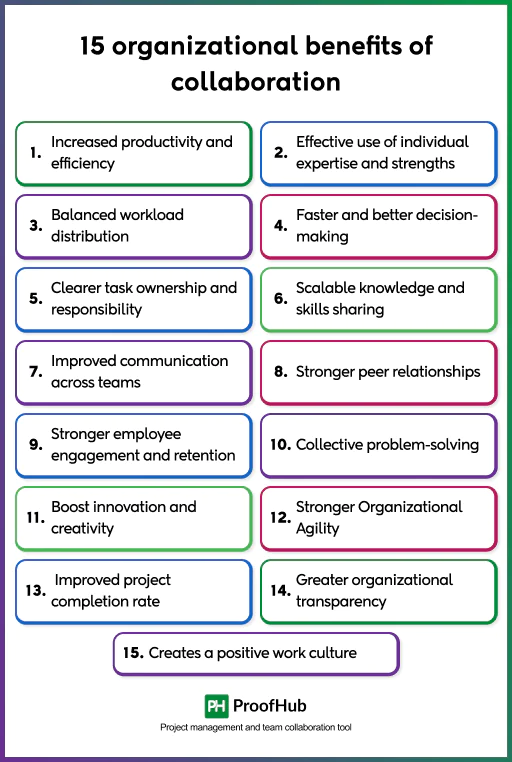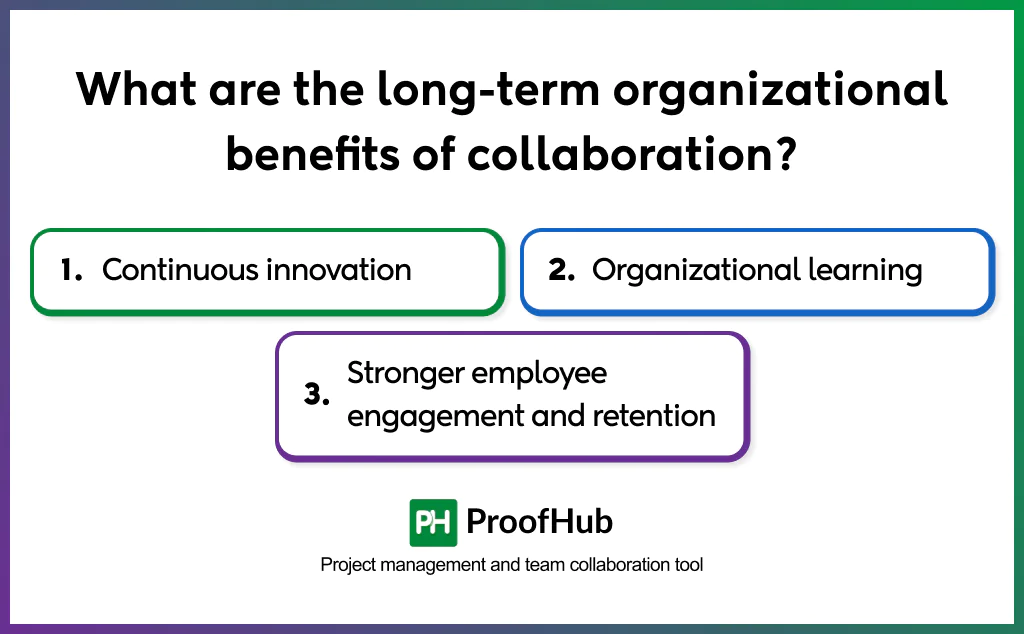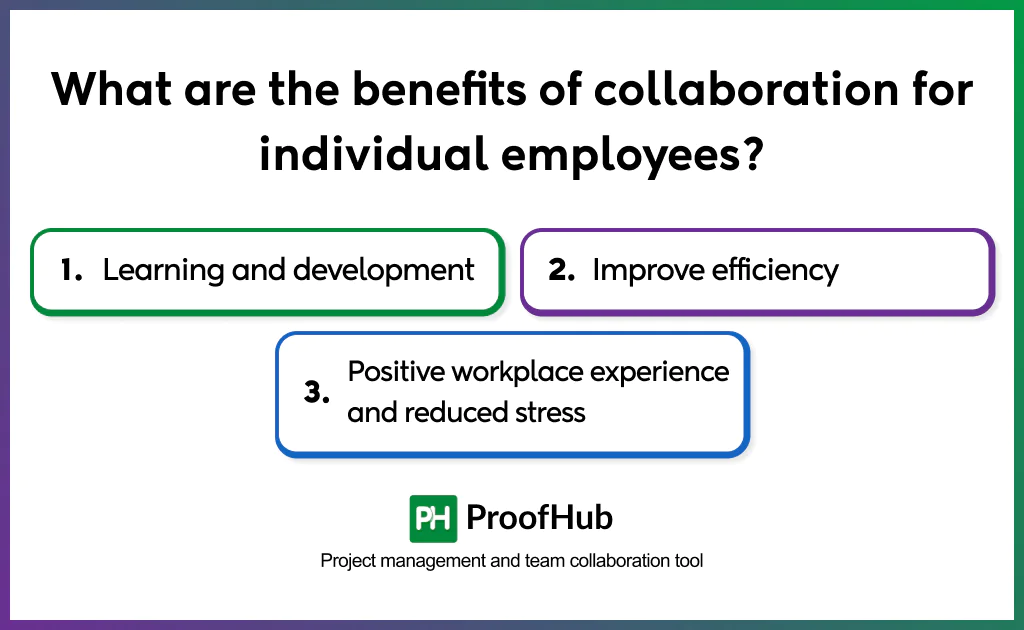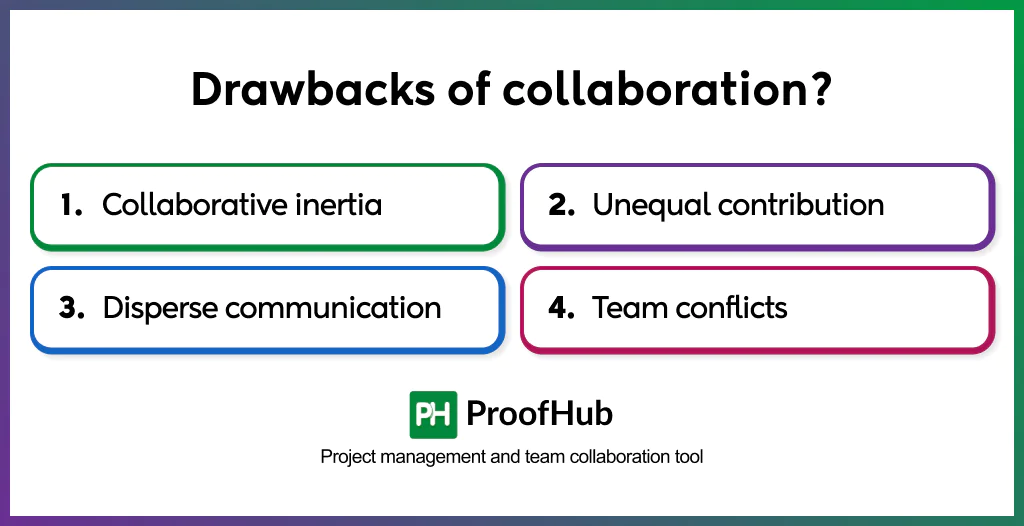
Effective collaboration offers numerous benefits to organizations, including enhanced productivity, better decision-making, increased knowledge sharing, effective team communication, strong interpersonal relationships, improved problem-solving, increased organizational agility, and a positive work environment.
Collaboration strengthens alignment between business objectives and daily activities, reducing duplication of efforts. Collaboration utilizes the collective intelligence of the group. This drives better decision-making as multiple people with diverse viewpoints approaching a problem generate solutions quickly than an individual working in isolation.
According to McKinsey & Company, high-performing teams are up to 25% more productive than their less collaborative counterparts.
At an individual level, collaboration increases engagement, builds trust, and fosters a culture of accountability, where contributions are visible and valued. Teams experience improved morale and stronger professional relationships, which enhance retention and job satisfaction.
This article explains the 15 key benefits of collaboration, how they impact organization’s growth, and why investing in collaborative practices should be a priority for organizations aiming to achieve sustainable success.

1. Increased productivity and efficiency
Collaboration improves productivity by leveraging diverse skills and perspectives, facilitating effective task delegation, promoting the frequent sharing of information, enhancing team alignment, and boosting employee engagement.
When individuals work together on a shared objective, they share knowledge, expertise, and viewpoints, leveraging each other’s diverse skills and strengths. This utilization of the collective intelligence, skills, and resources of the group helps teams find solutions to complex problems faster and complete tasks quickly compared to those working individually, leading to improved productivity.
Duncan J. Watts, in a research paper titled, Task complexity moderates group synergy, published that a group working on a complex task is faster and more efficient than the fastest and most efficient individual.
Collaboration involves the frequent exchange of information, sharing of documents, and communication about status updates among team members. This shared access to documents and data makes it easy for the team to find information, helping to save 19% of the time knowledge workers spend searching for and gathering information.
Additionally, when team members coordinate on tasks, they share updates, clarify misconceptions, and provide feedback. This enhanced collaboration fosters a shared understanding and enhances a team’s alignment on project objectives, progress, and expectations. This eliminates duplicated efforts, reduces friction, and breaks information silos, resulting in optimized processes and fewer bottlenecks, allowing the group to work efficiently and achieve more in less time.
A Gallup study finds a link between employee engagement and productivity, suggesting that highly engaged teams are 21% more productive.
2. Effective use of individual expertise and strengths
Collaboration enables the effective use of an individual’s knowledge and strengths by assigning tasks based on their strengths, leveraging complementary skills, and pooling the unique knowledge, skills, and perspectives of each individual.
When a team is formed, roles and tasks are assigned based on the motivation and strengths of individual team members. This results in better quality of work, improved efficiency, and enhanced performance, as individuals work in their areas of specialization and where they excel.
A multilevel study of collective strengths use and team performance published by the Department of Human Resource Studies, Tilburg University, suggests, “Allocating tasks based on an individual’s strengths fosters individual performance and benefits team performance.”
The skills of one individual complement those of another, filling the skill gaps and allowing team members to support and learn from each other. This enables teams to build on each other’s skills and knowledge, resulting in the effective utilization of each individual’s skills.
Utilizing the strengths and knowledge of individuals brings diverse viewpoints, abilities, and experiences to the table, leading to better utilization of individuals’ skills and expertise, which cannot happen if individuals work in isolation.
3. Balanced workload distribution
Collaboration improves workload distribution by ensuring the transparent distribution of tasks, creating shared visibility into team tasks, and fostering open communication about workload.
Collaboration requires the sharing of the project data, such as tasks, progress, and plans. The team generally uses centralized collaboration tools to share, track, and manage project data. These tools provide shared visibility into tasks and progress, such as a centralized view of all tasks, deadlines, and assignees. This transparency in the workload allows individuals to see the overall workload and identify if someone is overloaded while others are underutilized.
If there are imbalances in workload, collaboration tools can help identify overworkload on team members, and tasks can be easily reallocated. This shared and transparent overview helps reduce bottlenecks, prevents overload on any single participant, and reduces burnout with fair and equitable distribution of tasks.
The balanced workload distribution leads to additional benefits like significantly reduced stress levels, improved employee morale, and enhanced job satisfaction.
A study conducted by two private universities in Nigeria, the Department of Business Studies and the Nigeria Broadcast Academy, finds that when employees compare their workload with other employees of the same status or those on a higher income level and feel that they have a higher workload, they feel dissatisfied. The study recommends minimizing discrepancies in workloads across organisational status by making deliberate efforts, where possible, to balance workload.
4. Faster and better decision-making
Collaboration helps in faster and better decision-making in an organization by making the decision-making processes more inclusive and leveraging the diverse viewpoints and expertise of individuals in the group. A study published by the University of North Carolina shows that diverse teams outperform individuals about 87% of the time during business decision-making processes.
Unlike traditional decision-making, where decisions flow from top to bottom in the hierarchical structure, collaboration involves team members in the decision-making process. This collaborative decision-making improves the quality of information gathered, provides an opportunity to leverage diverse perspectives, and makes the assessment comprehensive. Individuals evaluate and analyze the problem from multiple angles.
This uncovers blind spots and errors that might be overlooked in individual decision-making processes. It also eliminates potential biases as individuals correct each other’s mistakes. This in-depth critical evaluation and assessment ultimately improve the accuracy and reliability of decisions, leading to higher-quality decision-making.
By pooling a broad array of experiences, viewpoints, and knowledge, collaborative decision-making outstrips an individual’s problem-solving and innovation abilities, leading to robust and better decision-making. A study published in the World Journal of Advanced Research and Reviews shows that teams that engage in collaborative decision-making tend to produce more innovative solutions than those working in isolation, as diverse viewpoints lead to more comprehensive problem-solving processes and the generation of a wide range of ideas and opinions.
5. Clearer task ownership and responsibility
Collaboration clarifies task ownership and responsibility by clearly defining the role, responsibilities, and performance metrics of each individual in a team and communicating how an individual’s work contributes to the overall workflow, goals, and objectives.
Effective collaboration ensures everyone knows what is expected of them as an individual contributor and as a team member, and also from each team member. Each individual knows how their efforts align with the shared goals and mission of the organization. This enhanced clarity and shared understanding of roles and responsibilities lead to clear task ownership and responsibility. This, in turn, prevents conflicts and minimizes misunderstandings, leading to improved teamwork and performance, increasing project success.
According to the report by Effectory, employees with role clarity are 53% more efficient and 27% more effective at work than employees who have role ambiguity.
6. Scalable knowledge and skills sharing
Collaboration promotes knowledge and skill sharing by creating an environment for learning. According to a study published by Dellotie, companies with strong collaboration practices are 5x more likely to share knowledge effectively, promoting collaborative learning and supporting organizational learning.
When team members with diverse skillsets work together, they share knowledge, perspectives, and experience. This allows team members to capitalize on each other’s knowledge base and skill sets and learn from each other’s skills.
Educational researchers have also found that collaborative learning occurs peer-to-peer or in larger groups through peer instruction, where individuals work in pairs or small groups to discuss concepts or find solutions to problems, address misunderstandings, and clarify misconceptions. This enhanced collaboration leads to knowledge acquisition, company-wide knowledge diversification, shared learning experiences, and skills development of employees.
7. Improved communication across teams
Collaboration improves communication across teams by facilitating the frequent exchange of information, creating a safe and open environment, and building positive interpersonal relationships.
When teams work together on a shared objective, they require a shared understanding of the project, goals, progress, roles, and responsibilities. Thus, team members regularly communicate about various project aspects, clarify misconceptions, coordinate on tasks, find solutions to problems, and share feedback.
This facilitates frequent discussions and sharing of information, promoting communication across teams. This collaborative communication in a team further reduces miscommunication, minimizes confusion, ensures everyone is on the same page, aligned with the project goals, and working towards the same objectives, leading to improved teamwork and performance.
Some of the key characteristics of effective communication are clarity, conciseness, correctness, completeness, empathy, respect, honesty, openness, feedback, and active listening.
A teaching case, Better Communication = Better Teams: A Communication Exercise to Improve Team Performance, says that a common source of such misunderstandings is miscommunication caused by differences in how people interpret everyday words and phrases. Communication reduces the likelihood of such a negative outcome.
Collaboration helps build positive interpersonal relationships by fostering trust among team members. This building of positive interpersonal relationships improves team communication, as the studies show that the relationship between communication and interpersonal relationships is a deeply intertwined and cyclical one, where each element is both a cause and an effect of the other.
8. Stronger peer relationships
Peer relationships are the connections between colleagues at similar levels within the organization. Collaboration builds stronger peer relationships by fostering trust, reducing communication barriers between team members, and creating a sense of belonging.
Collaboration also builds mutual respect as team members learn about each other’s contributions and roles. Both trust and mutual respect are vital for making social bonds and building stronger relationships, leading to improved peer relationships.
Collaboration requires open, honest, and transparent communication among team members on day-to-day tasks, feedback exchange, and brainstorming sessions to function effectively. This frequent communication reduces the communication barriers between team members and allows individuals to know each other both personally and professionally, which is vital for building interpersonal relationships.
The Uncertainty Reduction Theory (URT), developed by Charles Berger and Richard Calabrese, states, when strangers meet, their primary goal is to reduce uncertainty about each other. Communication is the primary vehicle used to reduce uncertainty between strangers during a first interaction, which helps in building a relationship.
Collaboration creates a sense of purpose and belonging. Individuals feel part of the community and connected to their team members, which helps develop friendships. This sense of belonging and camaraderie not only helps build stronger peer relationships but also improves workplace engagement.
Highly engaged team members celebrate each other’s accomplishments, provide peer-to-peer recognition, offer moral support during challenges, share informal moments, and turn to peers for advice, assistance, or encouragement. Building a positive work culture and peer relationships at the workplace. This improved employee engagement further leads to improved productivity, increased employee job satisfaction, reduced absenteeism, and better cooperation.
9. Improved employee engagement and retention
Collaboration boosts employee engagement and retention by creating a sense of belonging in the workplace, building meaningful relationships, and increasing social interactions.
When team members work together on shared goals and interdependent work, they develop a sense of ownership, build commitment to the team, and feel more connected to their work and team. This sense of community and belonging, and feeling valued for their contributions at the workplace, naturally leads to increased involvement in the work and workplace, improving employee engagement. This, in turn, boosts employee morale and motivation to give their best, which results in improved productivity.
According to Slack’s latest annual survey, The State of Work 2023, 82% of the respondents said the key driver of their productivity was feeling happy and engaged at work.
Collaboration improves employee retention by building meaningful relationships. While working collaboratively, team members frequently communicate, share information, and provide support. This builds trust among team members, which extends to social & emotional support, strengthening relationships. This camaraderie improves employee experience at the workplace and enhances job satisfaction, resulting in reduced turnover.
Research from Gallup (2023) revealed that employees who work in highly collaborative teams report significantly higher levels of engagement and job satisfaction.
On the other hand, a lack of team collaboration means fewer opportunities for interactions, which leads to loneliness and social isolation. This has a direct impact on employee retention, as EY found that 46 percent indicated they are likely to leave a job because of loneliness.
Improved employee engagement and retention as a result of collaboration further boosts organizational and individual productivity and performance, reduces absenteeism, and creates a positive culture at the workplace.
10. Collective problem-solving
Collaboration promotes collective problem-solving by leveraging the collective intelligence and diversity of the group, fostering critical thinking, and creating a structured environment for a more efficient and effective approach to problem-solving.
Collaboration enables individuals with diverse perspectives, experiences, and expertise to pool their knowledge, skills, and efforts to find a solution to a problem collectively. A team approaches the problem from multiple angles in collaborative problem-solving. This diversity of viewpoints and collective effort in problem-solving sparks a wide range of ideas, eliminates biases, and reduces blind spots, leading to more effective, efficient, and comprehensive problem-solving as compared to working in isolation. An HBR article by Alison Reynolds and David Lewis suggests that teams solve problems faster when they are more cognitively diverse.
Furthermore, collaboration promotes critical thinking, leading to effective collective problem solving.
Critical thinking can be described as the ability to question, to recognize ambiguity, and to make informed judgments and decisions.
Team members solving problems collaboratively analyze information objectively and critically, challenge assumptions, synthesize ideas, justify positions, and form reasoned judgments, leading to comprehensive problem solving, improved cognitive outcomes, and development of robust solutions.
Collaboration creates a structured environment of open communication by facilitating discussions, brainstorming together, and encouraging the sharing of ideas. Team members share a wide range of ideas and build upon each other’s suggestions to produce creative and innovative solutions, which might not occur in isolation, encouraging collective problem-solving.
11. Boost innovation and creativity
Collaboration boosts innovation and drives creativity by leveraging the diverse perspectives of individuals within the group and fostering an environment for the development of new ideas.
When individuals with diverse perspectives, backgrounds, and disciplines collaborate to find a solution to a problem, they exchange ideas, share experiences, and approach problems from multiple angles. This diversity of viewpoints, experiences, and expertise sparks creativity and innovation and results in faster and effective problem-solving, leading to the generation of more creative, innovative, and comprehensive solutions, which cannot happen in isolation.
The diversity and inclusion revolution review published by Deloitte suggests that diversity of thinking enhances innovation and creativity by about 20 percent.
Many organizations across the globe also believe diversity sparks innovative solutions. For example, Apple, Inc. believes the most innovative company must also be the most diverse.
Collaboration creates an ideal environment for cross-pollination and the development of ideas. It distributes the risks of experimentation to the group involved in brainstorming. This shared responsibility and accountability encourages individuals to share unique and creative ideas with confidence and build on each other’s knowledge. This results in the creation of novel and breakthrough solutions, which might not emerge in isolation.
Research shows that the more people involved, the greater the number of associations and the higher the chance of discovering breakthrough innovations.
12. Stronger Organizational Agility
Organizational agility is the ability of an organization to adapt, reinvent, innovate, and change quickly to respond to the turbulent changes in the market and technology. Key characteristics of organizational agility are adaptability, resilience, flexibility, speed of response, and continuous improvement.
Collaboration helps build stronger organizational agility by facilitating frequent communication and exchange of information, integrated decision making, fostering knowledge sharing, and building strong interpersonal relationships and organizational commitment.
The academic paper published by Wioleta Kucharska on the European Conference on Knowledge Management proves that Knowledge, Learning, and Collaboration cultures (KLC cultures) synergy supports organizational agility building. Further, it defines mutual trust among employees, risk-taking attitude, and critical thinking abilities as key mediators to achieve organizational agility.
Collaboration facilitates seamless cross-communication among departments, ensuring the free flow and rapid exchange of information through standard channels. This breaks down information silos, eliminates the information gap, and creates a centralized source of truth, which in turn improves alignment among departments and allows the organization to have access to the most updated information. This minimizes the time between sensing a change and taking action, allowing organizations to react quickly and respond more effectively to new opportunities and threats. This improved agility allows organizations to pivot quickly, redeploy resources, and adjust strategies in response to market dynamics.
A 2023 report by Deloitte found that organizations that prioritize cross-functional collaboration are more adept at adapting to market shifts, integrating new technologies, and addressing customer needs.
Collaboration supports integrated decision-making by allowing individuals with diverse perspectives to work together, find a solution to a problem, and make informed decisions. Paired with the free flow of information, this diversity of perspectives and collective intelligence and efforts of the group lead to faster and comprehensive problem solving, development of new ideas and innovative solutions, and quick, robust, and quality decision-making, which are crucial for rapid and effective responses to changing conditions.
Collaboration improves organizational agility by facilitating knowledge sharing and learning. Team members working together share expertise, skills, best practices, and knowledge, and learn from each other. They iterate rapidly, learn from failures, and continuously improve processes.
This prevents knowledge silos and reduces the skills gaps, enabling teams to build new skills quickly to strategically adapt to changes. The faster adaptation to new challenges and improved organizational agility ensure the business can pivot quickly without losing momentum to thrive in dynamic environments.
Effective collaboration in a team creates a sense of belonging to the work, team, and workplace. It helps build strong interpersonal relationships and improves organizational commitment. A strong workplace relationship allows teams to better respond to the changes by providing mutual support to each other and enhanced organizational commitment motivates team members to go above and beyond to achieve organizational goals and shifting priorities, enhancing organizational resilience.
13. Improved project completion rate
Collaboration helps in improving project completion rate by streamlining team communication, efficient task distribution, creating shared visibility, and improving risk management.
Collaboration facilitates effective communication in the project team by creating clear and open communication channels. This facilitates frequent discussions and makes it easy to exchange information, resulting in improved understanding of project requirements, goals, and expectations, reduced misunderstandings and confusion among team members, and keeping everyone on the same page.
Effective task delegation is a key characteristic of collaboration. Collaboration enables teams to assign tasks based on team members’ strengths and expertise. This helps complete tasks faster and more efficiently, increasing the likelihood of completing projects on time by improving efficiency.
A project team relies on collaboration tools for effective collaboration. Collaboration tools such as project management software create a centralized and shared source of truth for the project team. It streamlines workflows, enables task coordination, and tracks the project progress. This shared view of the project tasks, progress, and plan helps track the project progress, identify bottlenecks, avoid redundant work, and reallocate resources to complete a project within budget and time.
Collaboration brings together diverse perspectives and skills to improve the risk management of the project. When team members regularly discuss progress and potential issues and approach the problem from multiple angles, they can identify potential roadblocks or risks before they escalate into major problems that derail the project timeline. Paired with regular meetings, it helps catch errors early and ensures that project outputs meet requirements. This reduces the need for costly and time-consuming rework, resulting in improved project completion rates.
14. Greater organizational transparency
Organizational transparency is defined as the openness and honesty in communication and information sharing between employees and leadership.
Collaboration builds greater organizational transparency by fostering open sharing of information and creating a shared visibility into processes and responsibilities.
Effective collaboration in a team requires team members to share ideas, updates, feedback, progress, and information. This enhanced communication and information sharing breaks the barrier between departments, making it easier for everyone to see what others are working on and access relevant information. This breaks down the information silos and makes information accessible to all involved, leading to improved transparency.
Transparency also involves sharing information about the decision-making process and the reasoning behind decisions. Collaboration improves transparency by creating a shared and increased visibility into processes and responsibilities.
According to Deloitte, eighty-six percent of leaders surveyed in the 2024 Global Human Capital Trends research say that the more transparent the organization is, the greater the workforce trust, which is enabled by sharing information about decisions, results, strategies, and practices freely with workers, customers, investors, and other stakeholders using straightforward and plain language.
Team members share files, documents, and progress in a central place. This enhanced sharing of information creates increased visibility into processes and responsibilities and ensures that everyone can see the status of projects and understand how decisions are made, which promotes transparency and further increases organizational openness. This enhanced transparency and openness build trust among team members, which improves organizational commitment, interpersonal relationships, and creates a positive work culture.
15. Creates a positive work culture
Collaboration creates a positive work culture— an environment where individuals feel valued, supported, and motivated— by fostering trust and transparency through open communication and creating a sense of belonging to the work and the workplace.
Collaboration requires effective communication among team members to work together on shared goals. They share ideas, updates, concerns, questions, and feedback freely. This provides opportunities for employees to connect with colleagues. Frequent discussions and sharing of information on day-to-day tasks break the communication barrier between team members, resulting in building the foundation of trust, which is a vital component of a positive work culture.
Collaboration requires team members to work together on shared goals. Team members feel more connected, valued, and motivated when they support each other on interdependent work. They share knowledge, skills, expertise, and resources to support each other in achieving the objectives. This synergy creates a sense of community, builds commitment to the team, and facilitates strong interpersonal relations. This sense of belonging to the work and the workplace for team members reduces stress and makes work more enjoyable, leading to an improved work environment.
What are the long-term organizational benefits of collaboration?
Long-term organizational benefits of collaboration include sustained innovation, continuous organizational learning, better decision-making, improved organizational resilience, and increased employee engagement and retention. It is because collaboration is not a one-time act. It is the way of working. It creates a culture that encourages team members to work together, communicate openly, and share information. This ensures organizations are making the most of the individuals with diverse skill sets, perspectives, knowledge, expertise, and experience.

Here are the key long-term organizational benefits of collaboration:
- Continuous innovation: Team members share perspectives and experiment. This leads to continuous innovation, which helps in developing novel solutions. This ensures long-term competitiveness and adaptability of an organization in changing markets.
- Organizational learning: Collaboration is an act of sharing knowledge, skills, and resources. When continued for a long time, team members start learning from each other. This helps in organization-wide learning and upskilling. It reduces the learning and development costs and helps build resilient organizations.
- Stronger employee engagement and retention: A culture of collaboration means people are interacting, communicating, and working together on day-to-day activities. This naturally increases engagement, which helps in building trust, strong interpersonal relationships, and a positive workplace culture. This improves employees’ experience, enhances job satisfaction, and reduces turnover.
What are the benefits of collaboration to individual employees?
Collaboration offers a wealth of benefits for individual employees, such as enhanced learning and skill development, positive workplace experience, and improved efficiency, leading to improved well-being, reduced stress, and personal growth.

Here are the key benefits of collaboration for individual employees:
- Learning and development: While working together, individuals learn from each other through peer learning. Team members share knowledge, mentor each other, and share feedback. This naturally results in the expansion of one’s knowledge and capabilities. This collaborative learning is not only restricted to technical skills, but it also helps in the development of soft skills of an individual.
- Positive workplace experience and reduced stress: Collaboration makes an individual’s experience at the workplace positive. While working in a team, team members interact and support each other. This increased opportunities for interactions and a sense of community within the team helps reduce loneliness and stress by building social connections. Paired with peer recognition and feedback from the management, collaboration creates a positive employee experience at the workplace, resulting in reduced stress.
- Improve efficiency: Working together in a team allows individuals to utilize each other’s expertise and share resources, which helps in faster problem-solving and task completion, leading to improved personal efficiency and productivity. 70% of employees believe better collaboration can have a positive impact on employee productivity and time savings.
How do remote teams benefit from collaboration?
Remote teams benefit from collaboration in various ways, such as reducing loneliness, enhancing clarity, and streamlining workflows. Here is the brief explanation:
- Reduce loneliness: Isolation and loneliness are the biggest challenges faced by the remote team. According to Ringover’s 2024 Loneliness at Work survey, remote workers reported feeling lonely 98% more often than their fully onsite counterparts and 179% more often than those in hybrid roles. Effective collaboration naturally creates an environment that breeds communication and connection. Collaborative practices like virtual team-building activities and regular check-ins help remote workers connect. This helps battle isolation and loneliness.
- Enhance clarity: Collaboration in a remote team relies on digital collaboration tools such as project management software, like ProofHub, Asana, or Jira, and team chat apps like Slack, Teams, or Zoom. These digital tools bring projects, task management, and team communication to a centralized and transparent place. This clarifies roles and responsibilities, streamlines the workflow, and makes it easy to track progress.
- Improve communication: Digital collaboration tools make critical information easily accessible and bring transparency to communication. This reduces the risk of miscommunication or information silos and strengthens accountability, reduces confusion, and helps resolve conflicts. This centralization of project data, processes, workflows, and conversations ensures transparency and creates a shared understanding, which in turn builds trust among team members, leading to better interpersonal relationships and improved job experience.
Are there any drawbacks of collaboration?
Yes, collaboration has several drawbacks when not done effectively. The most notable drawbacks of collaboration are collaborative inertia, unequal contribution, role confusion, team conflicts, dispersed communication, trust issues, and increased cost of tools, technology, and training.

Here are the key drawbacks of collaboration when not managed effectively:
- Collaborative inertia: The essence of collaboration is multiple individuals sharing perspectives and discussing to reach a consensus. But the same act leads to collaborative inertia, where it gets difficult to reach consensus as you have to evaluate multiple viewpoints and address the concerns raised by each individual. This takes time and slows down the decision-making process. Also, the drive for consensus leads to groupthink, where dissenting viewpoints are suppressed. This impacts the quality of decisions.
- Unequal contribution: Not all team members make efforts equally. Some employees are more dedicated than others. This often leads to unequal contributions in a team. This may cause resentment among high-performing team members.
- Disperse communication: Effective collaboration does not occur automatically. Organizations need to create effective team communication and project collaboration systems. In the absence of a unified collaboration system, collaboration hinders operations, leads to confusion, causes disengagement, and results in workplace friction.
- Team conflicts: When individuals with diverse personalities and backgrounds work together, conflicts are inevitable at some point. If not resolved, it creates friction, undermines work quality, leads to workplace politics, and even results in project failure.
Can effective collaboration affect employee satisfaction?
Yes, effective collaboration has a profoundly positive impact on employee satisfaction. It creates a sense of belonging and connection, increases employee engagement, and builds strong interpersonal relationships. This leads to better employee job experience, increases job satisfaction, reduces stress, and promotes happiness, leading to enhanced employee satisfaction.
Can collaboration help reduce workplace conflicts?
Yes, collaboration helps reduce workplace conflicts by fostering open communication, creating a shared understanding, enhancing role and process clarity, and building trust among team members to facilitate conflict resolution. Collaborative cultures encourage honest, respectful communication where employees feel comfortable discussing concerns without fear of judgment. This open dialogue allows potential conflicts to be addressed proactively and reduces the likelihood of tensions and misunderstandings escalating.






